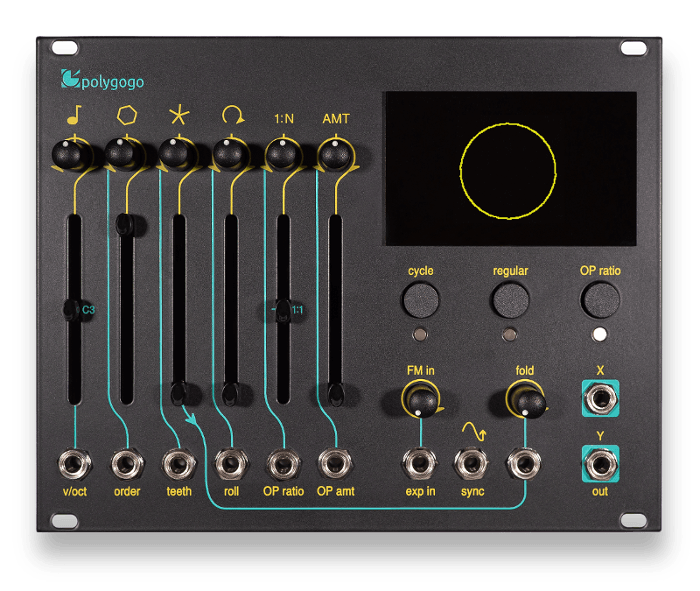polygogo
Graphical stereo oscillator with original Polygonal Synthesis.

Polygonal Synthesis was originally invented at E-RM by Maximilian Rest and Christoph Hohnerlein. It is based on complex two dimensional amplitude shaping of sine waves, combined with internal modulation sources and a new type of wave folder.
Hybrid Approach
The main algorithmic core is carried out on a digital processor to guarantee absolute frequency stability for internal modulations. The stereo wave-overflow output is classic analog circuitry, to retain unprecedented crispness and an open sound.
All-Access Interface
Its “single knob – single function” interface, created in collaboration with instrument designer Tatsuya Takahashi, makes the polygogo not only a terrific live performance synthesizer, but a great tool for meticulous sound design as well – no menus involved.
Sound Examples
All sounds polygogo
Polygonal Synthesis
Parameters explained

Order
Set the overtones
Order defines the number of corners on the polygon, which can range from a line (order 2) to an almost perfect circle (order 28) with all fractional settings in between. The number of corners defines the ratio of overtones with respect to the fundamental frequency: a low count keeps the harmonics near the fundamental frequency, a high order shifts them up.

Teeth
Bite through the mix
Teeth was the first happy accident while playing with the core formula of polygonal synthesis. It tilts the sides of the polygon out of the normal orientation and can be used to control the loudness of the overtones. It creates discontinuities in the waveform and acts as balance between the fundamental frequency and the overtone spectrum.

Roll
Animate the spectrum
Polygogo is a stereo oscillator. The output channels are derived directly from the X and Y pixel information, which means that both channels are slightly different most of the time. This leads to a great perception of space without any external effects. To animate the spectra of the two channels and create spatial movement, Roll rotates the object around the center and animates the waves.

Operator
Modulate with precise ratios
One of the benefits of a digital oscillator core is precise frequency tracking for linear FM modulation. Here, the builtin operator modulates the fundamental frequency for FM madness. FM Ratio is settable and quantizable, FM Amount goes from subtle growls in the lows to aliasing madness at high frequencies.

Fold
Overflow waves to the other side
Fold was the second happy accident while this instrument was created. Fold overflows the wave to the other side, leading to tickling noise at low settings and crushing and slicing the waveform to total distortion when fully turned up. This digital artifact was reproduced in analog circuitry and delivers the most crisp and open sound.
Technical Data
-
- High contrast OLED display
- 6 long range sliders with dust covers
- 8 high torque potentiometers
- 11 mini jack connectors for inputs and outputs
- 3 push buttons and leds
-
- Original Polygonal Synthesis core
- Builtin FM operator
- Low frequency panning modulator
- Analog wave overflow output stage
-
- 2x high speed V/oct and exponential FM inputs
(24 bit / 96 kHz) - 6x actively filtered CV inputs
(16 bit / 6 kHz) - 1x trigger input for hard sync
- 1x stereo output
- 2x high speed V/oct and exponential FM inputs
-
- 3U Eurorack module
- 32 HP wide, 26 mm in depth
- 110 mA @ +12 V
- 15 mA @ -12 V
- Weight: 266 g

